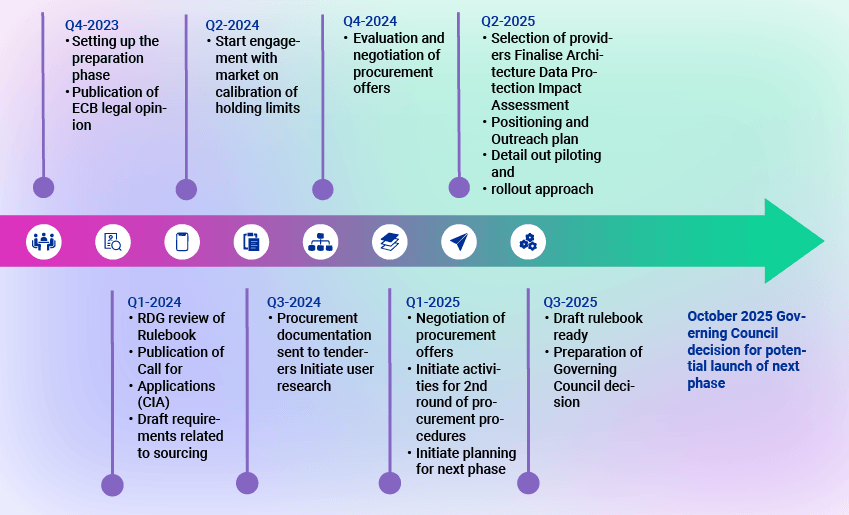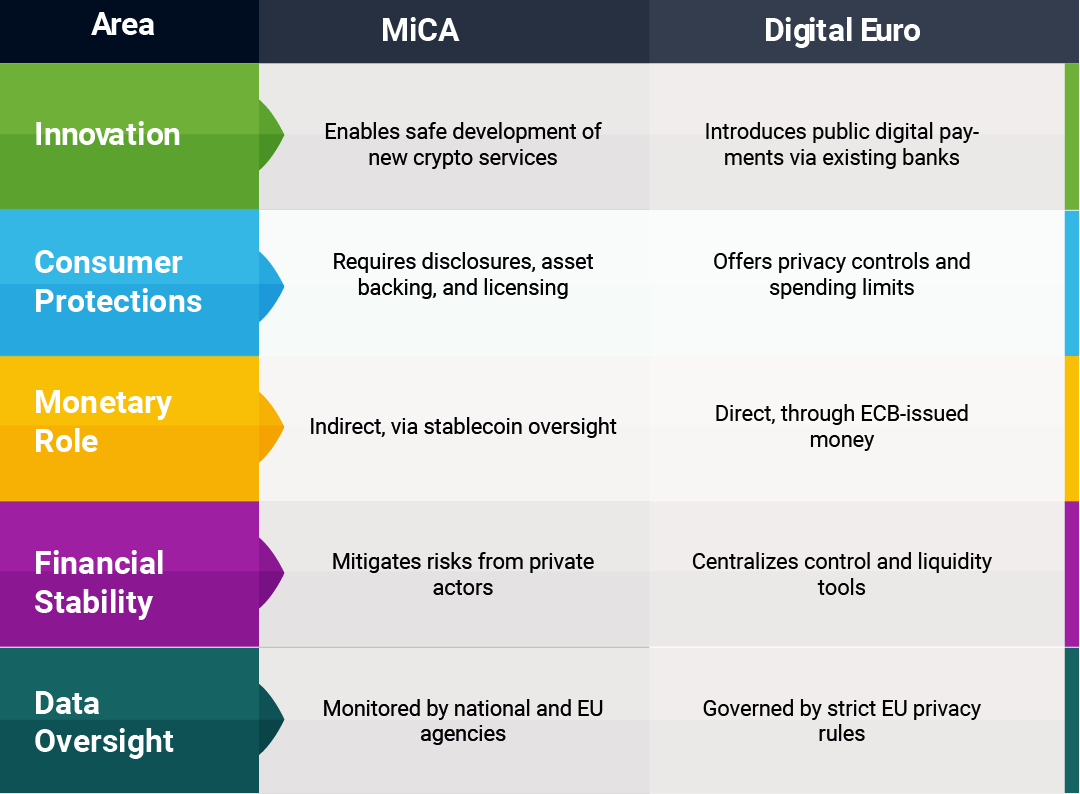A Financial Revolution in the Making
The European Union is stepping into a pivotal role as digital innovation reshapes how we think about money. From the rise of cryptocurrencies to the potential rollout of a Central Bank Digital Currency (CBDC), Europe is not only watching the transformation, but also helping drive it.
This article explores how the EU is balancing innovation with regulation by focusing on two major developments:
- The Markets in Crypto-Assets (MiCA) regulation, the first attempt to regulate Crypto.
- The digital euro project is steadily moving forward, with the potential to change the way people use and think about money in their everyday lives.
Together, these initiatives are shaping a future where finance, law, and technology are more deeply intertwined than ever before.
MiCA: Bringing Order to the Crypto Wild West
-
What is MiCA Regulations?
The Markets in Crypto-Assets Regulation, known as MiCA, is a groundbreaking legal framework designed to provide clarity and structure to the digital asset space across the EU. Officially adopted in 2023 and came into effect in December, 2024.
Until now, the crypto world in Europe has been something of a patchwork, with different countries applying their own rules. MiCA changes that by creating a single set of standards for digital assets, aiming to both protect users and encourage innovation.
-
What Does MiCA Cover?
MiCA addresses a broad spectrum of crypto-related activities. Here are some of its key features:
- Token Classification: It distinguishes between different types of digital assets from unbacked cryptocurrencies like Bitcoin to asset-referenced tokens (ARTs) and electronic money tokens (EMTs) As mentioned in Chapter 5 of Regulation (EU) 2023/1114.
- Requirements for Issuers:Anyone launching a crypto-asset must submit a detailed white paper outlining its features and risks. They’re also legally responsible for the information which provide as mentioned in Article 6 of Regulation (EU) 2023/1114.
- Reserves for Stability: Issuers of certain tokens, like EMTs, must hold a significant portion of their assets in safe, low-risk investments. This is meant to prevent collapse and promote stability as mentioned in Article 36 of Regulation (EU) 2023/1114.
- Licensing for Service Providers: Crypto platforms, custodians, and exchanges must be licensed and meet standards on anti-money laundering, cybersecurity, and risk management as mentioned in Article 63 of Regulation (EU) 2023/1114.
- Market Rules: Activities like insider trading or market manipulation are banned, and platforms must maintain a high degree of transparency as mentioned in Article 89 of Regulation (EU) 2023/1114.
- Oversight: National regulators will enforce these rules with support from EU-level bodies like the European Securities and Markets Authority (ESMA) and the European Banking Authority (EBA).
-
Why MiCA Matters?
MiCA goes beyond regulation, it’s about building confidence in the digital asset space by setting clear and fair standards. Here’s what it brings to the table:
- Legal Consistency: With a unified approach, businesses and investors can operate across borders without navigating conflicting national laws.
- Investor Protection: Clear guidelines and accountability reduce risks for both individual and institutional investors.
- Room to Innovate: While MiCA introduces rules, it also ensures they don’t stifle progress, giving tech innovators a stable environment to build in.
- Financial Stability: By managing risks tied to digital assets, the EU aims to prevent instability that could ripple into the broader financial system.
The Digital Euro: A New Kind of Public Money
-
The Legal Foundation
The legal basis for a digital euro is already baked into EU law. The European Central Bank (ECB) has the authority to issue currency, digital or otherwise, under Article 128 of the Treaty on the Functioning of the European Union. Article 133 allows lawmakers to set how it can be used. This legal provision gives the European Central Bank the authority to explore a digital version of the euro.
-
Timeline of the Digital Euro Project
Here’s a quick timeline of how the Digital Euro Project has progressed:
- 2021: The ECB commenced an official evaluation process for the Digital Euro Project.
- 2023: A preparation phase began, focusing on technical and regulatory design.
- 2024: Key issues like privacy, usability, and cybersecurity were studied in depth.
- 2025: A final decision on whether to move ahead is expected by the end of 2025.
-
How It Would Work
The digital euro would follow a two-tier model:
- The ECB would issue the currency and manage the core technology.
- Private institutions banks and payment service providers would handle day-to-day customer interactions, including setting up wallets and processing transactions.
The project will align with existing rules like PSD2 (for payment services) and EMD2 (for e-money), ensuring it fits into Europe’s financial system.
-
Balancing Privacy and Oversight
One of the biggest concerns is maintaining privacy. While cash offers near-total anonymity, digital money typically doesn’t. The ECB is working on a compromise:
- Small transactions could be made offline and pseudonymously, offering a degree of privacy.
- Larger transactions would remain traceable to prevent illegal activity.
- Data protection will be supervised by the European Data Protection Supervisor (EDPS), helping to safeguard individual rights.
-
Why Digital Euro Matters
A digital euro could bring several major benefits:
- Lower Costs: With fewer intermediaries, payments could become faster and cheaper for users and businesses alike.
- Greater Autonomy: Reducing dependence on foreign tech platforms helps strengthen Europe’s financial sovereignty.
- Monetary Flexibility: It gives central banks more tools to respond to economic challenges, especially in a world where cash is becoming less common.

Two Tools, One Strategy
-
Different Roles, Shared Goals
EU MiCA Regulations and the digital euro may focus on different parts of the digital economy, one on private crypto markets, the other on public digital currency, but they are clearly part of a coordinated effort. Notably, MiCA does not apply to central bank digital currencies like the digital euro, preventing legal overlap.
-
Working Together
Even though they operate in separate domains, the systems supporting MiCA and the digital euro will need to interact smoothly. That means ensuring consistency in areas like anti-money laundering compliance and cybersecurity standards. Over time, more legislation may be introduced to tie the ecosystem together more tightly.
-
A Combined Impact

Looking Ahead: Europe’s Digital Finance Model
The EU is laying the groundwork for a new financial era, one that aims to combine the reliability of public institutions with the agility of modern technology. Through Markets in Crypto-Assets (MiCA) regulation and the digital euro, Europe is building a framework that could set global standards for digital currency governance.
But success won’t come overnight. The EU must continue to listen, adapt, and refine its approach. If done right, it won’t just lead in digital finance, it will define how the world moves forward.
Disclaimer
The information provided in this article is intended for general informational purposes only and should not be construed as legal advice. The content of this article is not intended to create and receipt of it does not constitute any relationship. Readers should not act upon this information without seeking professional legal counsel.



